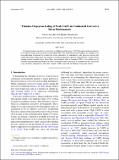| dc.contributor.author | Agard, Vince | |
| dc.contributor.author | Emanuel, Kerry Andrew | |
| dc.date.accessioned | 2018-04-06T13:46:52Z | |
| dc.date.available | 2018-04-06T13:46:52Z | |
| dc.date.issued | 2017-08 | |
| dc.date.submitted | 2017-06 | |
| dc.identifier.issn | 0022-4928 | |
| dc.identifier.issn | 1520-0469 | |
| dc.identifier.uri | http://hdl.handle.net/1721.1/114581 | |
| dc.description.abstract | A thermodynamic constraint on convective available potential energy (CAPE) in continental environments is established using an idealized one-dimensional model. This theoretical model simplifies the synoptic-scale preconditioning framework for continental severe convection by considering a dry adiabatic column that comes into contact with a moist land surface. A system of equations is derived to describe the evolution of the ensuing surface boundary layer. From these, the maximum value of transient CAPE in the column can be found for any particular combination of surface temperature and moisture. It is demonstrated that, for a given range of surface temperatures, the value of peak CAPE scales with the Clausius–Clapeyron relation. Keywords: Atmosphere; Convection; Severe storms; CAPE; Climate change; Thermodynamics | en_US |
| dc.description.sponsorship | United States. Office of Naval Research (Award N00014-14-1-0062) | en_US |
| dc.publisher | American Meteorological Society | en_US |
| dc.relation.isversionof | http://dx.doi.org/10.1175/JAS-D-16-0352.1 | en_US |
| dc.rights | Article is made available in accordance with the publisher's policy and may be subject to US copyright law. Please refer to the publisher's site for terms of use. | en_US |
| dc.source | American Meteorological Society | en_US |
| dc.title | Clausius–Clapeyron Scaling of Peak CAPE in Continental Convective Storm Environments | en_US |
| dc.type | Article | en_US |
| dc.identifier.citation | Agard, Vince, and Kerry Emanuel. “Clausius–Clapeyron Scaling of Peak CAPE in Continental Convective Storm Environments.” Journal of the Atmospheric Sciences 74, 9 (September 2017): 3043–3054 © 2017 American Meteorological Society | en_US |
| dc.contributor.department | Massachusetts Institute of Technology. Department of Earth, Atmospheric, and Planetary Sciences | en_US |
| dc.contributor.mitauthor | Agard, Vince | |
| dc.contributor.mitauthor | Emanuel, Kerry Andrew | |
| dc.relation.journal | Journal of the Atmospheric Sciences | en_US |
| dc.eprint.version | Final published version | en_US |
| dc.type.uri | http://purl.org/eprint/type/JournalArticle | en_US |
| eprint.status | http://purl.org/eprint/status/PeerReviewed | en_US |
| dc.date.updated | 2018-03-30T17:40:29Z | |
| dspace.orderedauthors | Agard, Vince; Emanuel, Kerry | en_US |
| dspace.embargo.terms | N | en_US |
| dc.identifier.orcid | https://orcid.org/0000-0002-2066-2082 | |
| mit.license | PUBLISHER_POLICY | en_US |
